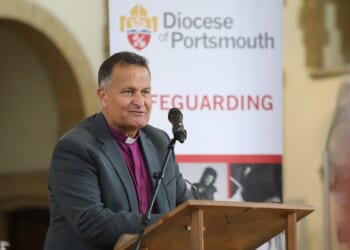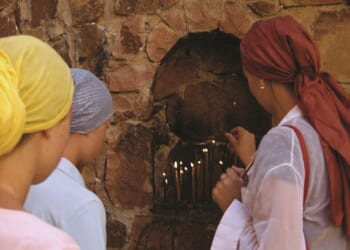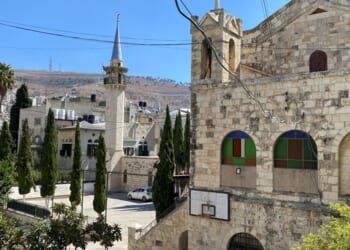Churchwarden’s lot
WHATEVER irritations I may occasionally give my vicar (we churchwardens wouldn’t be doing our jobs if we didn’t), at least I have not — so far — had him prosecuted.
Seventy years ago, the churchwarden of St Anne’s, Soho, landed her priest with the threat of a court summons, though Fr McLaughlin forgave her, and, when she died in 1957, let her ashes be interred beneath the tower. She lies there in a casket marked “Mrs Atherton Fleming”, though she is better known as Dorothy L. Sayers. In August, I was invited to give a lecture at the Sayers Society convention about her wardening.
The author of the Lord Peter Wimsey detective novels, who turned to plays and religious writing in the 1930s, had been invited by Fr McLaughlin to join a post-war literary society that he was setting up in the St Anne’s tower (which was all that remained after the Luftwaffe’s contribution to urban planning in London), and she was the first speaker in a series of lectures on “Christian faith and contemporary culture”. T. S. Eliot, C. S. Lewis, Agatha Christie, and John Betjeman (the first and last of whom also served as churchwardens) followed.
In 1952, Fr McLaughlin invited Sayers — who sometimes read the lessons at St Thomas’s, Regent Street, one of three churches in his urban benefice — to be one of his wardens. The prospect of a woman warden, especially a famous one, raised eyebrows in The Daily Telegraph. When Sayers asked what the office involved, the priest replied: “Nothing very much, unless the Bishop comes.” One of her main tasks, it seems, was to attend the sherry nights that he threw for local businesses and charm them into helping his mission. We all serve in our own way, even if what we serve is Tio Pepe.
Stay of execution
THREE years later, however, Sayers got him in trouble. In his excellent recent manual for wardens, Rotas, Rules and Rectors, Matthew Clements suggests that we are effectively a combination of “front of house” and “stage manager”. Sayers took this description literally, putting on plays at St Thomas’s from her first month in the job, beginning with one on Constantine.
It was an adaptation of her wartime BBC radio series The Man Born to be King which raised the ire of the Lord Chamberlain, who had not given permission for Christ to be depicted on stage. Worse, the church was charging admission.
A gloriously stinky letter was sent to Fr McLaughlin from his archdeacon, on the orders of the Bishop, saying that the Lord Chamberlain could “no longer turn a blind eye at the overt breaches of the law”, and was minded to send the case for prosecution. “You will not have a leg to stand on,” the archdeacon warned. “The church will be brought into disrepute and a lot of the undeniably useful work you are doing will be brought to a very abrupt end.” He added as a PS: “The Lord Chamberlain is in deadly earnest.”
Fr McLaughlin grovelled, and, four days later, received a letter from the Lord Chamberlain’s office, saying: “You will not on this occasion find yourself in the Courts!”
Final chapter?
I DISCOVERED all this during an enjoyable afternoon trawling through files of church correspondence in the Westminster City Council archives. It turns out that “Nothing very much” — her priest’s promise of what a churchwarden does — was the approach that Sayers took to matters of fabric and repairs, which she left to the PCC secretary (although there is a note from her saying that “Something will have to be done about the heating”).
She was good, though, at drumming up guest speakers for the 250th anniversary of the opening of St Thomas’s, starting with Michael Ramsey, but got a sniffy reply from the Archbishop of Canterbury, Geoffrey Fisher, who said he had a rule never to accept a parochial invitation from his former diocese. “Only the other day,” he wrote, “I refused an invitation from a church celebrating its 1,000th anniversary.”
Flicking through pages of church correspondence did make me think how unhelpful the age of email is for future historians. All my witty messages to the Vicar and helpful suggestions to the diocese (both of whom may disagree with those adjectives) will be lost to posterity.
Instead, our record of service will be reduced to mere faculty applications, finance returns, and bland Statistics for Mission. Perhaps we should print out and save all our church emails for future scholars, although that may get us marked down on the diocese’s energy footprint tool.
Noises off
PERHAPS Sayers’s best-loved Wimsey novel is The Nine Tailors, in which she demonstrated admirable research on the subject of bell-ringing. We have only two bells in our church — one for striking the hour, one for tolling — which earned this comment from my friend, David House, a former university administrator and keen bell-ringer: “Wardens without bell-ringers can count themselves fortunate in the same way as vice-chancellors without medical schools and their deans: they just bring problems and a lot of noise.”
I do love a full peal of bells, though, and cannot understand the grouches who buy a house next to an ancient church and then complain to the papers that they are disturbed by ringing. I am with Sayers, who wrote: “It seems strange that a generation which tolerates the uproar of the internal combustion engine and the wailing of the jazz band should be so sensitive to the one loud noise which is made to the glory of God.”
To the manor born
RECENTLY, I enjoyed hearing the bells of St Mary-le-Bow, when I attended a harvest festival for the 150th anniversary of the creation of London’s Pearly Kings and Queens.
These elaborately decorated working-class monarchs, who raise a great deal of money for charity, sang from the pearly songbook outside the Guildhall — rolling out the barrels, packing up their troubles, and boasting about their lovely coconuts — before walking down to the church on Cheapside whose bells traditionally create Cockneys. It was a charming service, and perhaps the first time I have heard a sermon begin with the words “Cor, blimey!” The Rector, the Revd Dr Simon Cuff, grew up in the East End, where he said he learned the Cockney values of “family, community, hospitality, welcome, and devotion”.
Bow bells’ reach isn’t what it was, however. A study a few years ago of the effect of modern ambient urban noise on the audibility of tintinnabulation (I assume it was called something like that, most studies are) discovered that, in the 1850s, St Mary-le-Bow’s peal could be heard six miles away in places like Stamford Hill, Leyton, and Stratford.
By 2012, the sound of their new bells — replaced after the Great Bell of Bow, of “Oranges and Lemons” fame, was destroyed in the Blitz — barely stretched out of the Square Mile to Shoreditch. Does that mean that true Cockneys are dying out? Or do aspiring parents of pearly princes and princesses play the Bow chimes via YouTube at the bedside in the maternity ward?
Patrick Kidd is a journalist and a churchwarden of All Saints’, Blackheath, in the diocese of Southwark.
















